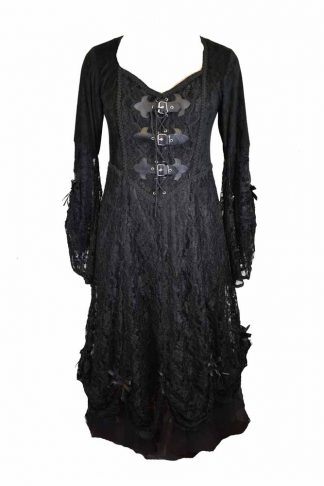The Gothic dressing culture, or gothic style, reached its peak in the 10th and 11thcenturies, and then again in the 14th centuries. When it all started, the Gothic dresses were heavily influenced by the Byzantine culture of the east. But due to slow communication, the western styles were lagging behind by 25-30 years. Towards the end of the middle ages, western Europe started designing their own clothes, people started the usage of button to fasten clothes.
Before this time, tailoring was primarily a woman’s job. But now it was slowly being taken over by the men. This also saw the introduction of individual clothing style. While the wealthier wore clothes with a typical pattern and crests that represented their family, the mass were functional clothes that would save them from the harsh climates until 14th century when the concept of unisex clothing came up. Be in summer or winter, men and women started wearing clothes, which were pretty much the same.
They usually wore long, flowing clothes and were completely covered, probably because of the Christian influence. Both wore an under-tunic and an over-tunic which was short and belted at the waist, something resembling the modern day skirt and blouse. While the rich wore cloaks lined with silk, gold cloth or fur, the working class wore breeches or shorter garments so that they can do the manual jobs easily.
The Gothic eras
Amid all these, Gothic fashion made its entry. Gothic style is a dark style of clothing that are worn by the Goth subculture. Gothic fashion clothing, often considered as a protest against extravagance and everything “normal” as tagged by the society. Alternative dresses, as it is often called, sees a major usage of black clothes, dark make up, corsets, fishnets, leather outfits, printed-tees, totem inspired accessories and so on.

Women’s Gothic dresses and the eras
Gothic fashion is generally divided into two periods- Early Gothic Period (1200-1350) and Late Gothic Period (1350-1450). The outfits that were worn in the Early gothic period were more sophisticated, classic in style, simpler in cuts than the Romanesque period. Sleeves were tighter and forearms were of more importance. The small, frilly trimmings, long dresses and deep necklines were some of the important features of early Gothic fashion.
But styles changed quickly in the next era, the Late Gothic period. The long, flowy drapes were metamorphosed into tighter, fitted clothes like corsets and fishnets. The upper body portions were the area of highlight. Tight belts, leg-o-mutton sleeves, crisp pleats were the new fashion inclusions in the late Gothic period.
The hairstyles
Men flaunted hair of a sensible length, in a bob to the jawline, with a bang across the forehead, during the Early Gothic period. Blonde hair was popular and men bleached their hair to achieve this look. Few wore beards too. In the later era, men donned neatly bobbed hair with curled ends.
In both the eras, young girls had their hair loose and flowing upon the shoulder, but after they got married, they tied their hair into neat buns anear their nape. Many types of hair accessories were also worn by them.
Men and women’s Gothic dresses
A corset belongs to the gothic fashion and is an important member of gothic women’s dresses. It shapes the body like an hourglass and makes it look more appealing. Gothic corsets and popular till date that forced designer to make this uncomfortable outfit to a softer and convenient wear.
Fishnets too, are an important member of the Gothic fashion. They are much favoured in the summers. Fishnets can be worn as stockings, on arms or even as shrugs. In summers, women are seen in lace-trimmed long skirt, cotton bloomers and flowy skirts, which are airy and comfortable to wear. Men used to don ruffled, buckled or lacy shirts similar to that of the pirate shirts.
Alternative dresses are incomplete without hats, black umbrellas, chunkyjewelleries and of course Gothic boots. While female Goths wore dark, high-heeled black boots, men wore heavy, black flat boots.
While these were just the basic of women’s gothic clothing and styling of Goths changed over the years as they branched out to different Gothic subcultures. Each gothic subculture has independent characteristics and similar dressing patterns, clothes and accessories.
ORDER YOUR PRODUCTS ON LINE BEST DEAL


























